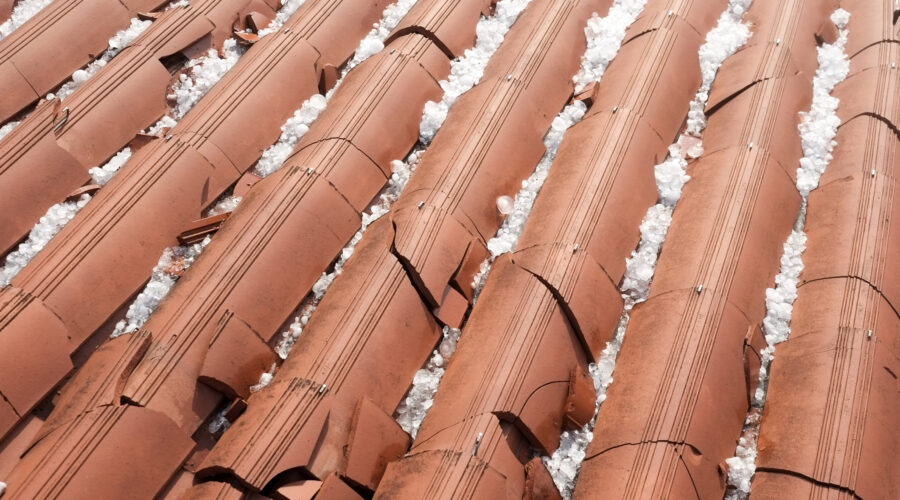How Hail Can Damage Your Roof Without Causing a Leak
When a hailstorm rolls through your area, the first thing most property owners check for is obvious damage — broken windows, dented siding, or water leaking from the ceiling. If everything looks fine on the surface, it’s easy to assume your roof survived unscathed.
But here’s the catch: hail damage isn’t always immediate or visible, and just because your roof isn’t leaking now doesn’t mean everything is okay.
At Revolve Construction, we’ve inspected thousands of roofs across Missouri and Illinois after severe storms. Time and again, we find that hail damage flies under the radar — until it’s too late and costly repairs are needed.
In this guide, we’ll break down exactly what hail does to your roofing system, why leaks may not show up right away, and why it’s critical to take action even if your roof looks fine.
How Hail Actually Damages a Roof
It’s More Than Just Dents
While hail can cause noticeable dents and cracks, some of the most serious damage happens beneath the surface. A standard hailstone may not seem like much, but when it slams into your roof at 60+ mph, it can compromise the system’s integrity.
Here’s how:
- Bruising of Shingles: Hail impacts can bruise or compress the protective granules on asphalt shingles, exposing the underlayment to the elements.
- Cracks or Splits: For older roofs, hail may cause cracking or splitting of shingles and tiles.
- Loss of Granules: Granules provide UV protection and fire resistance. Hail can knock them off, speeding up aging.
- Membrane Punctures: On flat roofs (like TPO or EPDM), hail can puncture or weaken the membrane, even without visible tears.
Why You Might Not See Leaks — Yet
Delayed Water Intrusion Is Common
One of the biggest misconceptions is that if your roof isn’t leaking immediately after a hailstorm, it must be fine. In reality, hail damage often sets the stage for leaks that can develop weeks, months, or even years later.
Here’s why:
- Protective layers are compromised, but not fully breached — yet.
- Small cracks or gaps allow slow moisture intrusion that builds up over time.
- UV exposure worsens damage where granules have been knocked away, accelerating decay.
- Interior leaks can be hidden inside walls, insulation, or attics before becoming visible.
Signs of Hail Damage to Watch For
Even if you’re not seeing leaks, keep an eye out for these warning signs:
- Dark or bald spots on shingles
- Dents in gutters, downspouts, or metal flashing
- Loose or missing shingle tabs
- Cracked skylights or vent covers
- Granules collecting in gutters
And remember: if your neighbors are getting inspections or repairs, there’s a good chance your property was affected, too.
Why Timely Inspections Matter
The longer you wait to address hail damage, the more expensive it becomes. Insurance companies also limit how long you have to file a claim after a storm — typically 6 to 12 months.
Benefits of Getting a Roof Inspection Right Away:
- Catch damage early before it leads to interior problems
- Protect your insurance rights by filing on time
- Get professional documentation for your claim
- Prevent small issues from becoming major repairs
At Revolve Construction, we provide free hail damage assessments — no pressure, no gimmicks. Just honest insights from trained professionals.
TPO, EPDM, and Shingle Roofs: How They Respond to Hail
Roof Type | Common Hail Damage | How It Progresses | Inspection Tip |
Asphalt Shingles | Granule loss, bruising, cracks | UV exposure worsens damage | Look for dark or smooth patches |
TPO Membrane | Surface dents, seam separation | Can lead to leaks over time | Check seams and around penetrations |
EPDM Rubber | Punctures, uplifted edges | May bubble or blister later | Look for signs of membrane loosening |
Still Not Sure If You Have Damage? Ask Yourself:
- Did a hailstorm pass through your area recently?
If yes, even a quick inspection is worth it. - Is your roof more than 5 years old?
Older roofs are more vulnerable to hail damage. - Have neighbors filed claims or gotten repairs?
Nearby damage usually means yours was impacted too. - Can you see granules in your gutters or downspouts?
This could signal hail has stripped the shingles.
Final Thoughts
Hail damage doesn’t always cause immediate leaks — but that’s exactly what makes it dangerous. Left unaddressed, even minor hail impacts can lead to major water damage, mold growth, and costly repairs down the road.
At Revolve Construction, we help property owners take the smart, proactive approach. Our trained inspectors know exactly what to look for — and how to document damage clearly for insurance claims.
Think your roof might have hail damage? Don’t wait for the first drip to take action.
Contact Revolve Construction today for a free inspection — and peace of mind




